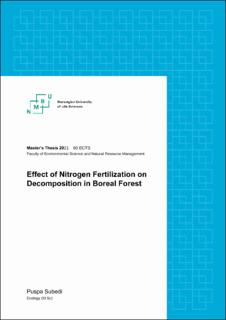Effect of nitrogen fertilization on decomposition in boreal forest
Master thesis
Permanent lenke
https://hdl.handle.net/11250/2787705Utgivelsesdato
2021Metadata
Vis full innførselSamlinger
- Master’s theses (MINA) [668]
Sammendrag
Anthropogenic activities have resulted in escalating deposition of nitrogen in many forms that impact several aspects of ecosystem especially lying on boreal region where N is a limiting factor for tree growth. Although N is used as forest fertilizer to some extent to enhance growth and carbon storage, it alters the ecosystem by altering microbial community, soil properties, aboveground species abundance and diversity and nutrient cycling through decomposition. To better understand the effects of N addition on decomposition, an experiment was carried out in a long-term N forest-fertilization set-up in south east Norway. The experiment followed the Tea Bag Index (TBI) protocol, where green and rooibos tea were used as standard litters and buried in fertilized and control plots for three months. The tea bags were sampled afterwards, and mass loss was measured to calculate the decomposition rate constant (k) and proportion of stabilized material (S). Mineral soil samples were also analyzed in the lab to measure pH, concentration of condensed tannins, and moisture. Bilberry and spruce litters were collected for a lab incubation experiment where they were kept on mesh on petri-discs filled with soil samples. This was done to analyze how litter quality affects the mass loss and nitrogen release during the decomposition process.
N fertilization significantly affected k and S values. Interestingly, k was higher in fertilized plots S was higher in control plots indicating higher decomposition under N fertilization. However, N treatment did not show any significant impact soil pH, C, N and CT, neither did the interaction between them significantly affected k and S. The litter incubation experiment showed that treatment and initial N concentration significantly affected N release from the litter, whereas no significant effect was found on mass loss percentage. My results indicate that increased N concentration in litter as a result of fertilization does not necessarily indicate faster decomposition.

